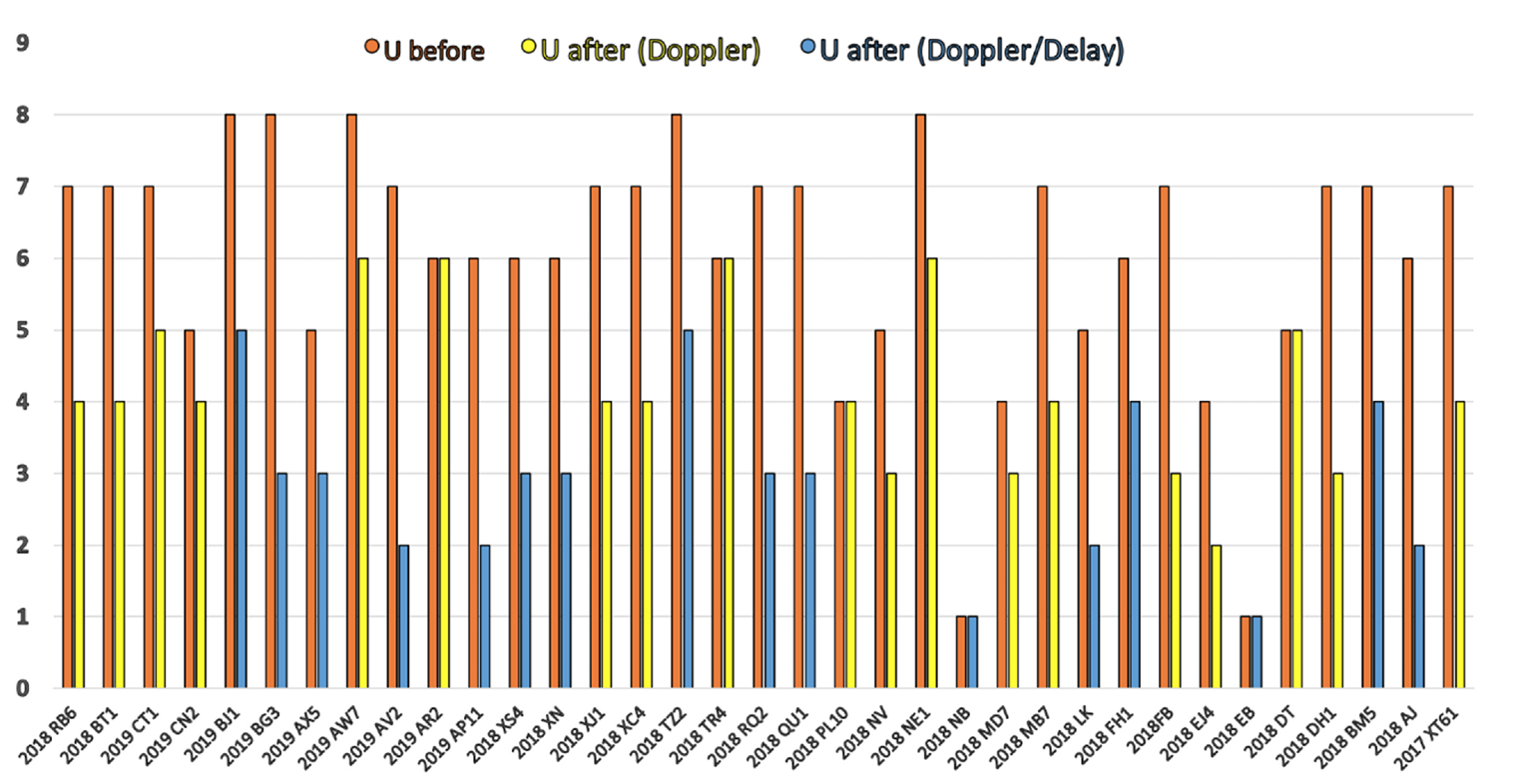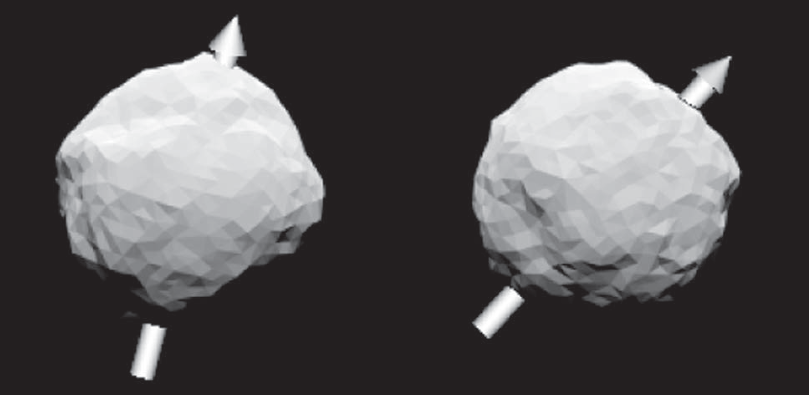Science Highlights for Planetary Radar at the Arecibo Observatory
Table of Contents
- The Arecibo Observatory’s legacy and future radar capabilities
- Arecibo Planetary Radar Observations of Near-Earth Asteroids: 2017 December – 2019 December
- Constraining the Limitations of NEATM-like Models: A Case Study with Near-Earth Asteroid (285263) 1998QE2
- Physical Characterization of 2015 JD1: A Possibly Inhomogeneous Near-Earth Asteroid
- The global thermophysical properties of (433) Eros
- Joint #TeamRadarCon & Mini-RF Meeting
- Peer-reviewed publications
- Conferences, workshops, meetings
New Science Results
The enormous database of radar data acquired by what was the most powerful radar system in the world continues to produce new, outstanding scientific results. Many of the newest publications were led by graduate students. See the list of publications here. A summary of just a few of the recent publications are below.
The Arecibo Observatory’s legacy and future radar capabilities
A team of scientists from the Arecibo observatory published a synopsis of the radar capabilities of the legacy Arecibo 305-m telescope and explored future radar concepts for both planetary defense and space situational/domain awareness.
The publication in Acta Astronautica was led by the Head of Radar at AO Flaviane Venditti, with AO co-authors Sean Marshall, Maxime Devogèle, Luisa Zambrano-Marin, and Anna McGilvray.
The report discusses the similarities in the instrumentation and operational requirements for conducting planetary defense observations of asteroids and Space Situational Awareness observations of orbital debris and reiterates the need for telescopes with radar capabilities like those lost upon the closure of the Arecibo Observatory.

Arecibo Planetary Radar Observations of Near-Earth Asteroids: 2017 December – 2019 December

Among the recent publications, former AO scientist Anne Virkki collaborated with a significant number of AO scientists, analysts, and engineers, as well as former scientists and students, to publish a comprehensive summary of the 191 near-Earth asteroids observed by Arecibo Planetary Radar between December 2017 and December 2019. Co-authors on the paper include Sean Marshall, Flaviane Venditti, Luisa Zambrano-Marín, Dylan Hickson, Anna McGilvray, Patrick Taylor, Edgard Rivera-Valentín, Maxime Devogèle, Eframir Franco Díaz, Sriram Bhiravarasu, Betzaida Aponte Hernández, Carolina Rodriguez Sánchez-Vahamonde, Michael Nolan, Phil Perillat, Israel Cabrera, Elliot Gonazález, Daniel Padilla, Victor Negrón, Juan marrero, Johnny Lebrón, Adrian Bagué, Francisco Jiménez, Andy López-Oquendo, Daniel Repp, Riley McGlasson, Brynn Presler-Marshall, Ellen Howell, Jean-Luc Margot, Sanjana Prabhu Desai.
The publication included delay-Doppler images of some of the targets, as well as estimations for their sizes and shapes. Four of the targets were determined to be binary asteroids, and another 10 were found to be contact-binary asteroids. The radar reflectances revealed that two of the planetary worlds may be metal-rich, and that there is possible evidence for water ice on one of the observed asteroids.
Samuel Myers, a graduate student at the University of Arizona and his advisor Ellen Howell, led a study to explore the limitations of using simple thermal models to derive key physical properties about asteroids. The team of scientists compared the results of simple thermal models with more complex thermophysical models, radar data, and other existing analyses and presented a method for more accurately determining physical properties of near-Earth asteroids when using simple models. The results were published in The Planetary Science Journal.

Physical Characterization of 2015 JD1: A Possibly Inhomogeneous Near-Earth Asteroid
Andy López-Oquendo, a current graduate student at Northern Arizona University, led a publication characterizing the potentially hazardous near-Earth asteroid 2015 JD1. Lopez-Oquendo had previously worked with the planetary radar team at Arecibo. The study included the near-simultaneous acquisition of delay-Doppler images from the Arecibo Observatory and near-infrared and photometric observations from the Lowell Discovery Telescope in 2019, as well as visible spectral measurements from Las Cumbres Observatory during a separate apparition. The in-depth analysis revealed that the asteroid is a contact binary with spectral variations across the surface, possibly due to lack of iron and sulfides and/or differences in grain sizes. The study is available in The Planetary Science Journal.

The global thermophysical properties of (433) Eros
Mary Hinkle, graduate student at the University of Central Florida, published an analysis of the global thermosphysical properties of the asteroid (433) Eros in Icarus. Eros was the target of NASA’s NEAR Shoemaker mission, which orbited and eventually landed on the asteroid from 2000 to 2001. The study, which included several current and former scientists at the Arecibo Observatory and at the University of Central Florida, collected a very large set of near-infrared reflectance spectra from the NASA Infrared Telescope Facility (IRTF). Through comparative models with the data, the team found that Eros’ thermal properties vary over its surface, which has important implications for the way scientists link remote sensing observations to the physical properties of near-Earth asteroids.

Joint #TeamRadarCon & Mini-RF Meeting

The Joint Mini-RF Team meeting and #TeamRadarCon was hosted at the Arecibo Observatory on May 15 - May 19.
The meeting facilitated discussions within the Lunar Reconnaissance Orbiter’s Mini-RF science team and with ground-based radar scientists. Beginning in 2012, the Mini-RF operated in bi-static mode, receiving the S-band radar signal transmitted by the Arecibo Observatory.
The joint meeting enabled presentations and in-depth discussions about ongoing research using the radar data obtained with the Arecibo Observatory, the Goldstone Observatory, and the Green Bank Observatory.
Scientists from across the globe attended the workshop in-person and remotely. Those who attended in-person were able to visit the observatory, where many of them had worked for years, one final time before science operations ceased on August 14th, 2023. For others, including many of the students actively conducting research using radar data, it was the only opportunity for them to see the facility that acquired that data.
Peer-reviewed publications
Virkki, A.K., Marshall, S.E., Venditti, F.C.F., Zambrano-Marin, L. F., Hickson. D., McGilvray, A., Taylor, P.A., Rívera-Valentin, E.G., Devogèle, M., Diaz, E.F., Bhiravarasu, S., Hernandez, B.A., Sanchez-Vahamonde, C.R., Nolan, M.C., Perillat, P., et al. Arecibo Planetary Radar Observations of Near-Earth Asteroids: 2017 December - 2019 December, The Planetary Science Journal, 3(9), p.222, 2022. https://iopscience.iop.org/article/10.3847/PSJ/ac8b72/meta
López-Oquendo, A., Trilling, D.E., Gustafsson, A., Virkki, A., Rivera-Valentín, E.G., Granvik, M., Chandler, C.O., Chatelain, J., Taylor, P. and Fernanda-Zambrano, L. Physical Characterization of 2015 JD1: A Possibly Inhomogeneous Near-Earth Asteroid. The Planetary Science Journal, 3(8), p.189, 2022. https://iopscience.iop.org/article/10.3847/PSJ/ac7e4f/meta
Statler, T.S., et al (including Venditti, F. C. F.). After DART: using the first full-scale test of a kinetic impactor to inform a future planetary defense mission. The Planetary Science Journal, 3(10), p.244, 2022. https://iopscience.iop.org/article/10.3847/PSJ/ac94c1/meta
Hinkle, M.L., Howell, E.S., Fernández, Y.R., Magri, C., Vervack Jr, R.J., Marshall, S.E., Crowell, J.L. and Rivkin, A.S. The global thermophysical properties of (433) Eros. Icarus, 382, p.114939, 2022. https://doi.org/10.1016/j.icarus.2022.114939
MacLennan, E.,Marshall, S. and Granvik, M. Evidence of surface heterogeneity on active asteroid (3200) Phaethon. Icarus, 388, p.115226, 2022. https://doi.org/10.1016/j.icarus.2022.115226
Myers, S.A., Howell, E.S., Magri, C., Vervack, R.J., Fernández, Y.R., Marshall, S.E. and Taylor, P.A. Constraining the Limitations of NEATM-like Models: A Case Study with Near-Earth Asteroid (285263) 1998 QE2. The Planetary Science Journal, 4(1), p.5, 2023. https://iopscience.iop.org/article/10.3847/PSJ/aca89d
Seligman, D.Z., Farnocchia, D., Micheli, M., Vokrouhlický, D., Taylor, A.G., Chesley, S.R., Bergner, J.B., Vereš, P., Hainaut, O.R., Meech, K.J. and Devogele, M.. Dark comets? Unexpectedly large nongravitational accelerations on a sample of small asteroids . The Planetary Science Journal, 4(2), p.35, 2023. https://iopscience.iop.org/article/10.3847/PSJ/acb697/meta
Venditti, F. C. F., Marshall, S.E., Devogèle, M., Zambrano-Marin L.F., McGilvray, A. The Arecibo Observatory's legacy and future radar capabilities. Acta Astronautica, 210, pp.610-615, 2023. https://doi.org/10.1016/j.actaastro.2023.05.023
Kueny, J.K., Chandler, C.O., Devogéle, M., Moskovitz, N., Pravec, P., Kučáková, H., Hornoch, K., Kušnirák, P., Granvik, M., Konstantopoulou, C., Ferrais, M., and Jannsen, N.E. Implications for the formation of (155140) 2005 UD from a new convex shape model. The Planetary Science Journal, 4(3), p.56, 2023. https://iopscience.iop.org/article/10.3847/PSJ/acc1e7/meta
Morgado, B.E., et al. (including Ferrais, M.). A dense ring of the trans-Neptunian object Quaoar outside its Roche limit. Nature, 614(7947), pp.239-243, 2023. https://www.nature.com/articles/s41586-022-05629-6
Masiero, J.R., Devogèle, M., Macias, I., Jaimes, J.C. and Cellino, A.. The Increasingly Strange Polarimetric Behavior of the Barbarian Asteroids. The Planetary Science Journal, 4(5), p.93, 2023. https://iopscience.iop.org/article/10.3847/PSJ/acd383/meta
Zambrano-Marin, L.F., Howell, E.S., Taylor, P.A., Marshall, S.E., Devogèle, M., Virkki, A.K., Hickson, D.C., Rivera-Valentín, E.G., Venditti, F.C.F., and Giorgini, J.D., Radar and Optical Characterization of Near-Earth Asteroid 2019 OK, The Planetary Science Journal, 3(6), p.138, 2022.
Campbell, B.A. and Campbell, D.B., Arecibo Radar Maps of Venus from 1988 to 2020, The Planetary Science Journal, 3(3), p.55, 2022.
McGlasson, R.A., Marshall, S.E., Venditti, F.C., Naidu, S.P., Benner, L.A., Brozović, M., Giorgini, J.D., Taylor, P.A., Aponte, B., Virkki, A.K. and Harris, A.W., Radar and Lightcurve Observations and a Physical Model of Potentially Hazardous Asteroid 1981 Midas, The Planetary Science Journal, 3(2), p.35, 2022.
Conferences, workshops, meetings
#TeamRadar presented ongoing scientific research at a number of conferences, workshops, and meetings:
- The International Astronautical Congress, September 18-22, 2022. Paris,
France.
- F. Venditti, Marshall, S., M. Devogèle, L.F. Zambrano-Marin, McGilvray, A. The Arecibo Observatory’s legacy and future radar capabilities
- L.F. Zambrano-Marin, E. Howell, F. Venditti. Fast Rotating Near Earth Asteroids Observed with Arecibo Planetary Radar System
- Europlanet Science Congress 2022 (EPSC), September 18-23, 2022, Granada,
Spain.
- M. Devogèle. Radar shape modeling and physical characterization of the PHA 1998 OR2.
- 53rd Division for Planetary Science meeting, October 3-7, 2022. London, ON,
Canada.
- Marshall, S, The changing rotation period of 3200 Phaethon
- A. McGilvray, Shape Model of 2015 DP155 Using Radar and Lightcurve Observations
- F. Venditti, The population of binary and triple near-Earth asteroids observed with the Arecibo planetary radar system
- Small Bodies Assessment Group Meeting (SBAG), January 24-25, 2023. Pasadena,
CA, USA.
- F. Venditti, The Arecibo Observatory planetary radar updates
- Planetary Defense Conference, 3-7 April 2023, Vienna, Austria.
- F. Venditti, The Potentially Hazardous Binary and Triple Near-Earth Asteroids Observed with the Arecibo Planetary Radar System
- L.F. Zambrano-Marin, 2020 BX12: The last binary asteroid discovered by Arecibo Observatory
- S. Marshall, Capabilities of Past, Present, and Future Radar Systems for Observations of Near-Earth Objects
- M. Devogèle, Physical Characterization and Shape Model of 1998 OR2 Shows its Surface is Heterogeneous
- M. Ferrais, Calibrate the polarization-albedo relationship for NEOs by combining radar, polarimetric and optical lightcurves data.
- Asteroids, Comets, and Meteors Conference (ACM), 18-23 June 2023, Flagstaff,
AZ, USA.
- F. Venditti, The ones that got away? Investigating binary NEAs previously not identified in radar observations
- L.F. Zambrano-Marin, Radar Beaming Through the Solar System’s Asteroids, Comets, and Radar: Tally of 40 Years of Arecibo Observatory’s Planetary Radar System Observations
- S. Marshall, Arecibo Observatory asteroid projects
- M. Devogèle, Second Lunation Near-Earth Object Follow-Up with the Lowell Discovery Telescope
- M. Ferrais, Photometric Monitoring of NEAs Observed in Radar
- 6th Planetary Data Workshop, 26-28 June 2023, Flagstaff, AZ, USA.
- Lawton P. J., F. Venditti, et al. The Capture and Preservation of the Arecibo Pre-Archive Radar Data
- The Near-Earth Object Workshops to Assess Reconnaissance for Planetary
Defense (NEO WARP 2), 28-29 June 2023, Laurel, MD, USA.
- F. Venditti, S. Marshall (panel participation)
